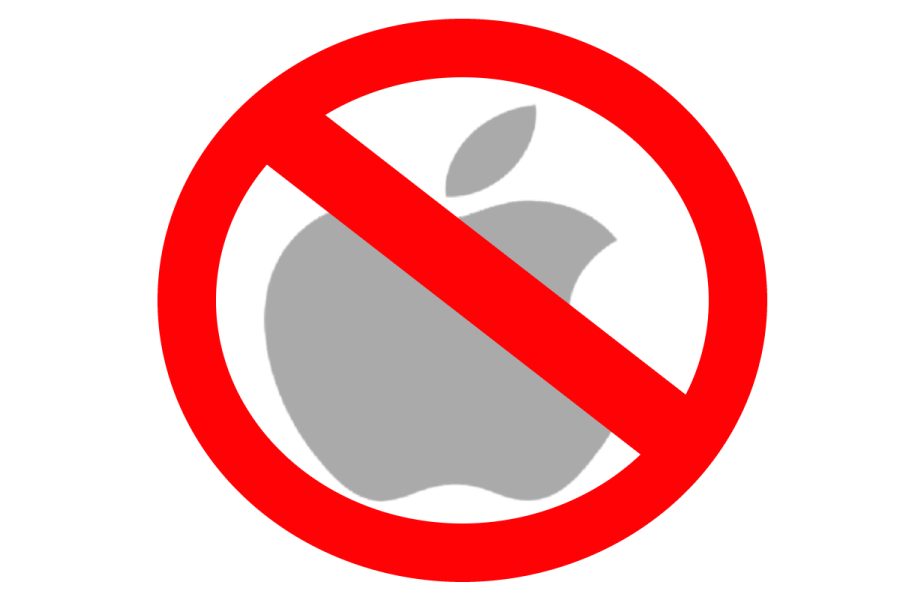Apple v. Freedom
December 6, 2022
Do you value personal freedom? If your answer is yes, I’d like you to reach into your pocket right now.
If you’re holding an iPhone, you should think again about your answer. Apple intentionally limits consumers’ freedoms through restrictive software, hardware, and business practices. If you really value freedom, you need to stop supporting Apple with your wallet.
Apple has been simplifying consumer technology since the original Macintosh personal computer. Before the Macintosh, personal computers were for enthusiasts; they were too bulky, expensive, and difficult to understand for the average person, but the Macintosh was different. Instead of plain green text, the Macintosh used images and graphics to represent the computer’s systems. Finally, there was a computer that the average person could own and use without a computer science degree. By adding these revolutionary features, Apple made the personal computer into a household essential. But since then, they’ve chosen to simplify products the easier way: by removing features.
On January 9, 2009, Steve Jobs announced the iPhone. Since that day, they’ve become ridiculously popular, generating $190 billion in revenue in 2021. With every iteration, they improved in camera quality, battery life, and screen resolution, but on September 7, 2016, Apple introduced a new strategy: Making the iPhone worse. They revealed the iPhone 7, whose most notable change from the iPhone 6s wasn’t any exciting new feature, instead it was the removal of the headphone jack.
Critics scoffed at the essential feature’s removal, saying Apple removed an essential component of the phone to sell more of their new wireless earbuds (Airpods). Essentially, Apple created a problem, and then sold its solution. But when the phones came out, the response wasn’t negative; in fact, sales were extraordinarily positive. The iPhone 7 and iPhone 7 Plus became the fourth best-selling smartphones ever, selling 160 million units. Airpods, which critics scoffed at as being a cheap cash grab, also became wildly popular. With the iPhone 7’s popularity, customers told Apple that they wouldn’t punish them for limiting their choices, even if that meant making a worse product.
Apple learned quickly, and soon applied this lesson to the whole iPhone lineup. In late 2017, iPhone users noticed that when the new iOS (iPhone software) update came out, their phone’s performance noticeably dropped. Users across the world accused Apple of purposefully slowing down older phones to boost the sales of new phones. Apple eventually responded to these allegations, saying that new updates were just too big for older phones to handle, and throttling old phones’ performances would stop their batteries from degrading.
But after even more hate, Apple gave in and buried the option to choose between battery health or performance optimization deep within the iOS Settings menu. Even when users got wise to Apple taking away their choice over their phone’s performance, Apple responded half-heartedly, because people were still buying their phones in droves. If customers really wanted a solution, they should’ve stopped buying iPhones. To a corporation, a drop in revenue is a much louder message than a few angry tweets.
Apple has even taken their “no-options” policy outside of the realm of software and hardware, and into the world of repairs. For reference, tech repairs fall into a few categories: Self-repairs, independent repair shops, and manufacturer repairs. The latter two are the most reliable, with a manufacturer repair being an almost guaranteed fix. Apple really wants its users to go directly to them for their repairs, inventing unique tools to open their products, and requiring a certification before sending those tools to independent repair shops.
They claim their strictness is because of the risk involved with repairing a phone. After all, modern smartphones are complex computers, and a botched repair could cause errors, broken parts, or even injury. However, most repair shops are reliable, and Apple’s high in-house repair prices make clear that their goal isn’t really to protect their users’ safety, it’s to exorbitantly raise repair rates until customers decide it would be easier to buy a new product.
For example, if your iPhone X’s screen shatters, you have a few options: You can purchase a new screen from a third party seller and try to replace the screen yourself (which is risky), you can use a third party Apple-certified repair shop (which are rare), or you can bring your phone directly to Apple (which is guaranteed to work). Understandably, you’ll probably choose to take your broken screen straight to an Apple store.
But the Apple repair costs $329, and for only $100 more, you could buy a brand new 2022 iPhone SE. Through high repair costs, Apple restricts consumer freedom to sell more products. To them, there’s far more incentive to sell a customer a new phone than to offer an affordable price to save their current one.
By monopolizing the repair market for their own phones, Apple controls every single aspect of their products’ lifespan, from the hardware, to the software, to the very process of owning the machine. You would think that users would object to this kind of treatment, that they would want more autonomy over the possessions they spend so much time on, but they don’t. They keep buying the products, regardless of Apple’s tightening grip.
If consumers want control over their tech, the answer is really simple: Stop buying Apple products.




